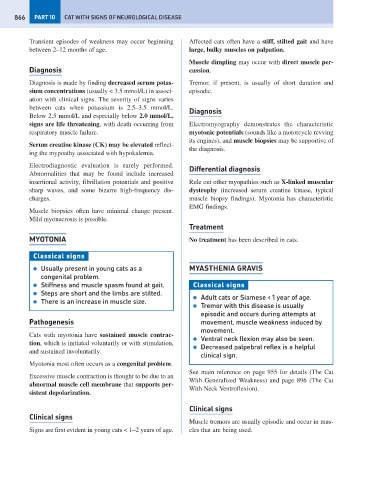Page 874 - Problem-Based Feline Medicine
P. 874
866 PART 10 CAT WITH SIGNS OF NEUROLOGICAL DISEASE
Transient episodes of weakness may occur beginning Affected cats often have a stiff, stilted gait and have
between 2–12 months of age. large, bulky muscles on palpation.
Muscle dimpling may occur with direct muscle per-
Diagnosis cussion.
Diagnosis is made by finding decreased serum potas- Tremor, if present, is usually of short duration and
sium concentrations (usually < 3.5 mmol/L) in associ- episodic.
ation with clinical signs. The severity of signs varies
between cats when potassium is 2.5–3.5 mmol/L.
Diagnosis
Below 2.5 mmol/L and especially below 2.0 mmol/L,
signs are life threatening, with death occurring from Electromyography demonstrates the characteristic
respiratory muscle failure. myotonic potentials (sounds like a motorcycle revving
its engines), and muscle biopsies may be supportive of
Serum creatine kinase (CK) may be elevated reflect-
the diagnosis.
ing the mypoathy associated with hypokalemia.
Electrodiagnostic evaluation is rarely performed.
Differential diagnosis
Abnormalities that may be found include increased
insertional activity, fibrillation potentials and positive Rule out other myopathies such as X-linked muscular
sharp waves, and some bizarre high-frequency dis- dystrophy (increased serum creatine kinase, typical
charges. muscle biopsy findings). Myotonia has characteristic
EMG findings.
Muscle biopsies often have minimal change present.
Mild myonecrosis is possible.
Treatment
MYOTONIA No treatment has been described in cats.
Classical signs
● Usually present in young cats as a MYASTHENIA GRAVIS
congenital problem.
● Stiffness and muscle spasm found at gait. Classical signs
● Steps are short and the limbs are stilted.
● Adult cats or Siamese < 1 year of age.
● There is an increase in muscle size.
● Tremor with this disease is usually
episodic and occurs during attempts at
Pathogenesis movement, muscle weakness induced by
movement.
Cats with myotonia have sustained muscle contrac-
● Ventral neck flexion may also be seen.
tion, which is initiated voluntarily or with stimulation,
● Decreased palpebral reflex is a helpful
and sustained involuntarily.
clinical sign.
Myotonia most often occurs as a congenital problem.
See main reference on page 955 for details (The Cat
Excessive muscle contraction is thought to be due to an
With Generalized Weakness) and page 896 (The Cat
abnormal muscle cell membrane that supports per-
With Neck Ventroflexion).
sistent depolarization.
Clinical signs
Clinical signs
Muscle tremors are usually episodic and occur in mus-
Signs are first evident in young cats < 1–2 years of age. cles that are being used.

